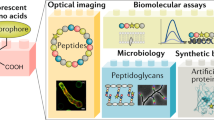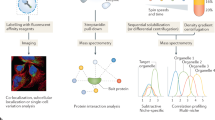Abstract
Methods to visualize, track, measure and perturb proteins in living cells are central to biomedicine's efforts to characterize and understand the spatial and temporal underpinnings of life inside cells. Although fluorescent proteins have revolutionized such studies, they have shortcomings, which have spurred the creation of alternative approaches to chemically label proteins in live cells. In this review we highlight research questions that can be addressed using site-specific chemical labeling and present a comparison of the various labeling techniques that have been developed. We also provide a 'roadmap' for selection of appropriate labeling techniques(s) and outline generalized strategies to validate and troubleshoot chemical labeling experiments.
This is a preview of subscription content, access via your institution
Access options
Subscribe to this journal
Receive 12 print issues and online access
$259.00 per year
only $21.58 per issue
Buy this article
- Purchase on Springer Link
- Instant access to full article PDF
Prices may be subject to local taxes which are calculated during checkout



Similar content being viewed by others
References
Lippincott-Schwartz, J. & Patterson, G.H. Development and use of fluorescent protein markers in living cells. Science 300, 87–91 (2003).
Lisenbee, C.S., Karnik, S.K. & Trelease, R.N. Overexpression and mislocalization of a tail-anchored GFP redefines the identity of peroxisomal ER. Traffic 4, 491–501 (2003).
Tsien, R.Y. The green fluorescent protein. Annu. Rev. Biochem. 67, 509–544 (1998).
Tsien, R.Y. Fluorescent indicators of ion concentrations. Methods Cell Biol. 30, 127–156 (1989).
Campbell, R.E. et al. A monomeric red fluorescent protein. Proc. Natl. Acad. Sci. USA 99, 7877–7882 (2002).
Gaietta, G. et al. Multicolor and electron microscopic imaging of connexin trafficking. Science 296, 503–507 (2002).
Marek, K.W. & Davis, G.W. Transgenically encoded protein photoinactivation (FlAsH-FALI): acute inactivation of synaptotagmin I. Neuron 36, 805–813 (2002).
Tour, O., Meijer, R.M., Zacharias, D.A., Adams, S.R. & Tsien, R.Y. Genetically targeted chromophore-assisted light inactivation. Nat. Biotechnol. 21, 1505–1508 (2003).
Rajfur, Z., Roy, P., Otey, C., Romer, L. & Jacobson, K. Dissecting the link between stress fibres and focal adhesions by CALI with EGFP fusion proteins. Nat. Cell Biol. 4, 286–293 (2002).
Tanabe, T. et al. Multiphoton excitation-evoked chromophore-assisted laser inactivation using green fluorescent protein. Nat. Methods 2, 503–505 (2005).
Allbritton, N.L., Oancea, E., Kuhn, M.A. & Meyer, T. Source of nuclear calcium signals. Proc. Natl. Acad. Sci. USA 91, 12458–12462 (1994).
Amara, J.F. et al. A versatile synthetic dimerizer for the regulation of protein-protein interactions. Proc. Natl. Acad. Sci. USA 94, 10618–10623 (1997).
Tsien, R.Y. Imagining imaging's future. Nat. Rev. Mol. Cell. Biol. (Suppl.) SS16–21 (2003).
Griffin, B.A., Adams, S.R. & Tsien, R.Y. Specific covalent labeling of recombinant protein molecules inside live cells. Science 281, 269–272 (1998).
Chen, I. & Ting, A.Y. Site-specific labeling of proteins with small molecules in live cells. Curr. Opin. Biotechnol. 16, 35–40 (2005).
Adams, S.R. et al. New biarsenical ligands and tetracysteine motifs for protein labeling in vitro and in vivo: synthesis and biological applications. J. Am. Chem. Soc. 124, 6063–6076 (2002).
Stroffekova, K., Proenza, C. & Beam, K.G. The protein-labeling reagent FLASH-EDT2 binds not only to CCXXCC motifs but also nonspecifically to endogenous cysteine-rich proteins. Pflugers Arch. 442, 859–866 (2001).
Martin, B.R., Giepmans, B.N., Adams, S.R. & Tsien, R.Y. Mammalian cell-based optimization of the biarsenical-binding tetracysteine motif for improved fluorescence and affinity. Nat. Biotechnol. 23, 1308–1314 (2005).
George, N., Pick, H., Vogel, H., Johnsson, N. & Johnsson, K. Specific labeling of cell surface proteins with chemically diverse compounds. J. Am. Chem. Soc. 126, 8896–8897 (2004).
Vivero-Pol, L., George, N., Krumm, H., Johnsson, K. & Johnsson, N. Multicolor imaging of cell surface proteins. J. Am. Chem. Soc. 127, 12770–12771 (2005).
Chen, I., Howarth, M., Lin, W. & Ting, A.Y. Site-specific labeling of cell surface proteins with biophysical probes using biotin ligase. Nat. Methods 2, 99–104 (2005).
Howarth, M., Takao, K., Hayashi, Y. & Ting, A.Y. Targeting quantum dots to surface proteins in living cells with biotin ligase. Proc. Natl. Acad. Sci. USA 102, 7583–7588 (2005).
Keppler, A. et al. A general method for the covalent labeling of fusion proteins with small molecules in vivo. Nat. Biotechnol. 21, 86–89 (2003).
Keppler, A., Pick, H., Arrivoli, C., Vogel, H. & Johnsson, K. Labeling of fusion proteins with synthetic fluorophores in live cells. Proc. Natl. Acad. Sci. USA 101, 9955–9959 (2004).
Juillerat, A. et al. Engineering substrate specificity of O(6)-alkylguanine–DNA alkyltransferase for specific protein labeling in living cells. ChemBioChem. 6, 1263–1269 (2005).
Miller, L.W., Sable, J., Goelet, P., Sheetz, M.P. & Cornish, V.W. Methotrexate conjugates: a molecular in vivo protein tag. Angew. Chem. Int. Edn Engl. 43, 1672–1675 (2004).
Miller, L.W., Cai, Y., Sheetz, M.P. & Cornish, V.W. In vivo protein labeling with trimethoprim conjugates: a flexible chemical tag. Nat. Methods 2, 255–257 (2005).
Farinas, J. & Verkman, A.S. Receptor-mediated targeting of fluorescent probes in living cells. J. Biol. Chem. 274, 7603–7606 (1999).
Worn, A. & Pluckthun, A. Stability engineering of antibody single-chain Fv fragments. J. Mol. Biol. 305, 989–1010 (2001).
Guignet, E.G., Hovius, R. & Vogel, H. Reversible site-selective labeling of membrane proteins in live cells. Nat. Biotechnol. 22, 440–444 (2004).
Rozinov, M.N. & Nolan, G.P. Evolution of peptides that modulate the spectral qualities of bound, small-molecule fluorophores. Chem. Biol. 5, 713–728 (1998).
Marks, K.M., Rosinov, M. & Nolan, G.P. In vivo targeting of organic calcium sensors via genetically selected peptides. Chem. Biol. 11, 347–356 (2004).
Marks, K.M., Braun, P.D. & Nolan, G.P. A general approach for chemical labeling and rapid, spatially controlled protein inactivation. Proc. Natl. Acad. Sci. USA 101, 9982–9987 (2004).
Juillerat, A. et al. Engineering substrate specificity of O6-alkylguanine DNA alkyltransferase for specific protein labeling in living cells. ChemBioChem 6, 1263–1269 (2005).
Hoffmann, C. et al. A FlAsH-based FRET approach to determine G protein–coupled receptor activation in living cells. Nat. Methods 2, 171–176 (2005).
Gao, X. et al. In vivo molecular and cellular imaging with quantum dots. Curr. Opin. Biotechnol. 16, 63–72 (2005).
Author information
Authors and Affiliations
Corresponding author
Ethics declarations
Competing interests
The authors declare no competing financial interests.
Rights and permissions
About this article
Cite this article
Marks, K., Nolan, G. Chemical labeling strategies for cell biology. Nat Methods 3, 591–596 (2006). https://doi.org/10.1038/nmeth906
Published:
Issue Date:
DOI: https://doi.org/10.1038/nmeth906
This article is cited by
-
Streamlined Biotinylation, Enrichment and Analysis for Enhanced Plasma Membrane Protein Identification Using TurboID and TurboID-Start Biotin Ligases
The Journal of Membrane Biology (2024)
-
A conformational switch in clathrin light chain regulates lattice structure and endocytosis at the plasma membrane of mammalian cells
Nature Communications (2023)
-
A diversity-oriented rhodamine library for wide-spectrum bactericidal agents with low inducible resistance against resistant pathogens
Nature Communications (2019)
-
Bio-additive-based screening: toward evaluation of the biocompatibility of chemical reactions
Nature Protocols (2019)
-
Development of an effective protein-labeling system based on smart fluorogenic probes
JBIC Journal of Biological Inorganic Chemistry (2019)



